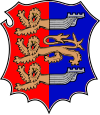Hastings, England
|
Hastings Borough of Hastings |
||
|---|---|---|
| Town and Borough | ||

Hastings Castle, with the Pier and Town Centre in the background
|
||
|
||
 Hastings shown within East Sussex |
||
| Sovereign state | United Kingdom | |
| Country | England | |
| Region | South East England | |
| County | East Sussex | |
| Area | ||
| • Total | 29.72 km2 (11.47 sq mi) | |
| Population (2011 census) | ||
| • Total | 90,300 | |
| • Density | 3,000/km2 (7,900/sq mi) | |
| Postcode | TN34 • TN35 • TN36 • TN37 • TN38 | |
| Website | Hastings Borough Council | |
Coordinates: 50°51′23″N 0°34′22″E / 50.8563015°N 0.5728745°E
Hastings /ˈheɪstɪŋz/ is a town and borough in East Sussex on the south coast of England, 24 mi (39 km) east of the county town of Lewes and 53 mi (85 km) south east of London, which has an estimated population of 90,254.
Hastings gives its name to the Battle of Hastings in 1066. It later became one of the medieval Cinque Ports. The town became a popular seaside resort in the 19th century with the coming of the railway. Hastings is a fishing port with a beach-based fishing fleet.
The first mention of Hastings is found in the late 8th century in the form Hastingas. This is derived from the Old English tribal name Hæstingas, meaning `the constituency/followers of Hæsta'. Symeon of Durham records the victory of Offa in 771 over the Hestingorum gens, that is, "the people of the Hastings tribe.", Hastingleigh in Kent was named after that tribe. The place name Hæstingaceaster is found in the Anglo-Saxon Chronicle entry for 1050, and may be an alternative name for Hastings. However, the absence of any archaeological remains of or documentary evidence for a Roman fort at Hastings suggest that Hæstingaceaster may refer to a different settlement, most likely that based on the Roman remains at Pevensey.
...
Wikipedia

